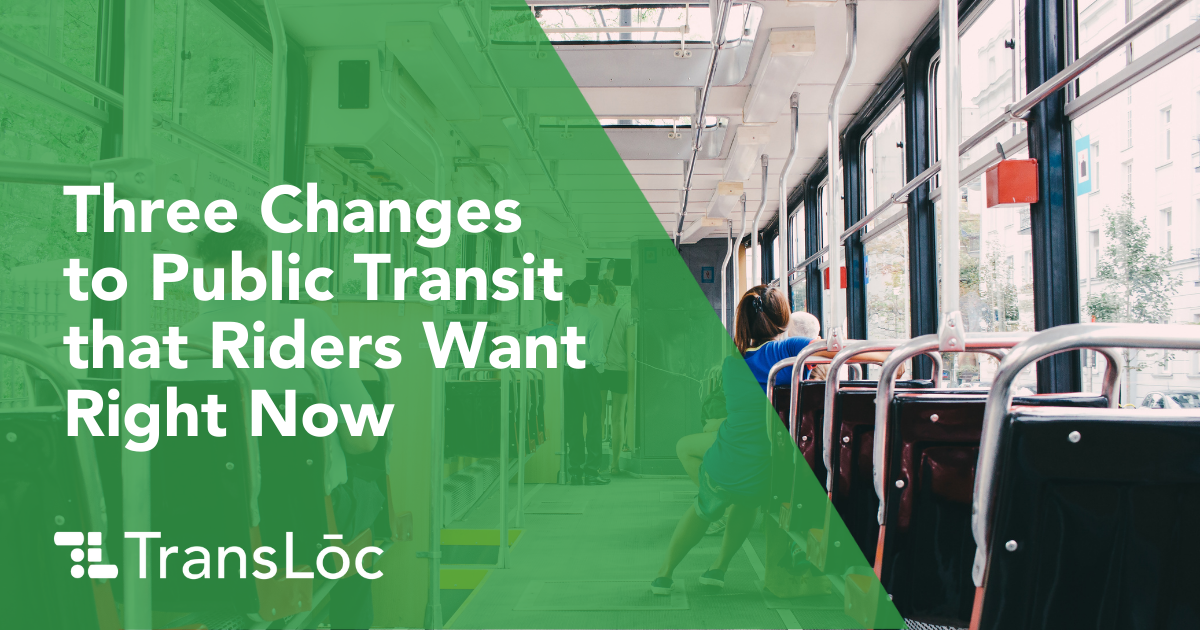
TransLoc’s Transit Value Index (TVI) showed that public transit riders want safe, sustainable, and seamless mobility options.
To get there, transit agencies will need to rely on trustworthy data, innovative technology, and the voices of their riders.
We hosted an expert roundtable featuring transit planners, tech pros, and community engagement specialists and asked them what it will take to make a fully-integrated, planet-saving mobility system a reality.
Here is what they’re focused on.
Public health protocols and capacity-tracking hardware to meet rider expectations
According to the TVI, 25% of transit riders plan to use personal vehicles more than before the pandemic. COVID-19 exposure is a major concern for riders across the country, and they want to see improved sanitation and social-distance protocols powered by smart technology.
Enforcing mask policies, implementing contactless fare payment, and installing new vehicle air filtration systems will go a long way, but riders want to make informed decisions about their health prior to boarding. They need accurate information about passenger capacity for their route of choice. Automatic passenger counters — on-board hardware used to track boarding and alighting — can prevent overcrowding by relaying real-time capacity numbers. This helps transit operators optimize route performance, and gives riders the data they need to choose the best route for their journey.
As technology makes it easier for transit agencies to accumulate and share transit data, rider expectations will increase. Austin Stanion, TransLoc’s manager of solutions engineering, outlined how data accessibility helps riders make smarter choices about their mobility options.
Eco-friendly mobility that emphasizes efficiency and on-time performance
Mention sustainability in a conversation about public transportation, and you’re certain to hear the term “electric vehicles” more than once. EVs will undoubtedly paint mobility with a new shade of green, but it’s not the only mobility solution that’s holding a brush.
Eco-friendly mobility will also be achieved by reducing the number of empty fixed-route buses on the streets, incorporating complementary on-demand microtransit services that provide efficient door-to-door service or connections to transit hubs, and improving headway performance.
Transit agencies that leverage performance and community data can make strategic decisions about how to best deploy their services, which also saves another kind of green: cash! Emory University optimized door-to-door performance to cut down on wasteful usage while keeping cash in their pockets.
A convenient, seamless transportation system built on community values
The abundance of mobility solutions and technology can push riders away from public transit if left unchecked. The TVI found that 69% of riders use two or more modes of transportation to get to work. Multi-modal journeys are the norm for many transit riders, which is why they want a cohesive suite of transit options — fixed route, on-demand, and micromobility — in an open, single-pay ecosystem. Riders must be able to plan, track, and pay in a single tech platform. The more unintegrated tech that is introduced to riders, the more complicated the riders’ experience.
And rider experience is what this all boils down to. Transit agencies are passionate about serving their communities, but good intentions can only take transit agencies so far. They must listen to the needs of their riders. Rider feedback is critical in launching or refining transit services and enticing the community to use these services instead of relying on private vehicles or ridesharing companies.
Tricia Thomas, content marketing manager at PublicInput, knows the power of a public engagement strategy that ensures all voices are heard. Hear why Tricia believes aligning community values with future transit plans will lead to success in an excerpt from a webinar:
To learn more about the mobility topics that are on the minds of today’s transit riders, download the Transit Value Index Report. Tell us what you learned on social, and let’s chat about how we can partner together to bring the transit future to your community.